
Visit Bürgersaalkirche in central Munich to see a stunning Baroque interior, but more importantly, introduce yourself to a hero, Father Rupert Mayer.
It’s easy to overlook the Bürgersaalkirche in favor of other more well-known sites in central Munich, but you shouldn’t. We wandered in one morning, drawn in by the building’s appealing Baroque facade. When we walked back out, we’d been introduced to the story of a hero, Father Rupert Mayer.
Those of us who love Munich can find it hard to reconcile our feelings with the city’s 20th century past. Even with a history dating from the 12th century consisting of both ecclesiastical and imperial influences, it’s almost impossible not to associate modern Munich – aside from Octoberfest – for its links with the rise and downfall of the Third Reich. Stepping inside the Bürgersaalkirche, which dates back to the 18th century, the last thing we expected to see was a museum dedicated to a priest who resisted the Nazis. We took note of the brochures with the Jesuit’s portrait in the narthex area of the church, but still had no idea who Father Rupert Mayer was and what he stood for.
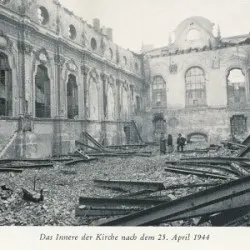
The Marian Congregational history in Munich dates back to 1610 when seventeen individuals gathered. By 1710, when the Bürgersaalkirche was built by Swiss architect Giovanni Antonio Viscardi, the congregation numbered 3,000. Viscardi also worked on the Nymphenburg Palace expansion beginning in 1702, and Dreifaltigkeitskirche (Trinity Church) in Munich. Members of Marian Sodale congregations, referred to as Sodalen (for solidarity within Christ, the Catholic church and Mary – the mother of all believers) are called to face the demands of God in daily life, in their own environment.
The Bürgersaalkirche was virtually destroyed by Allied bombing in 1944. Today, it has been fully restored. Its exterior facade is pretty, but also rather unassuming by comparison with neighbors and contemporaries.

The Upper Church is entered from either side via a stairway, each adorned with impressive statuary.
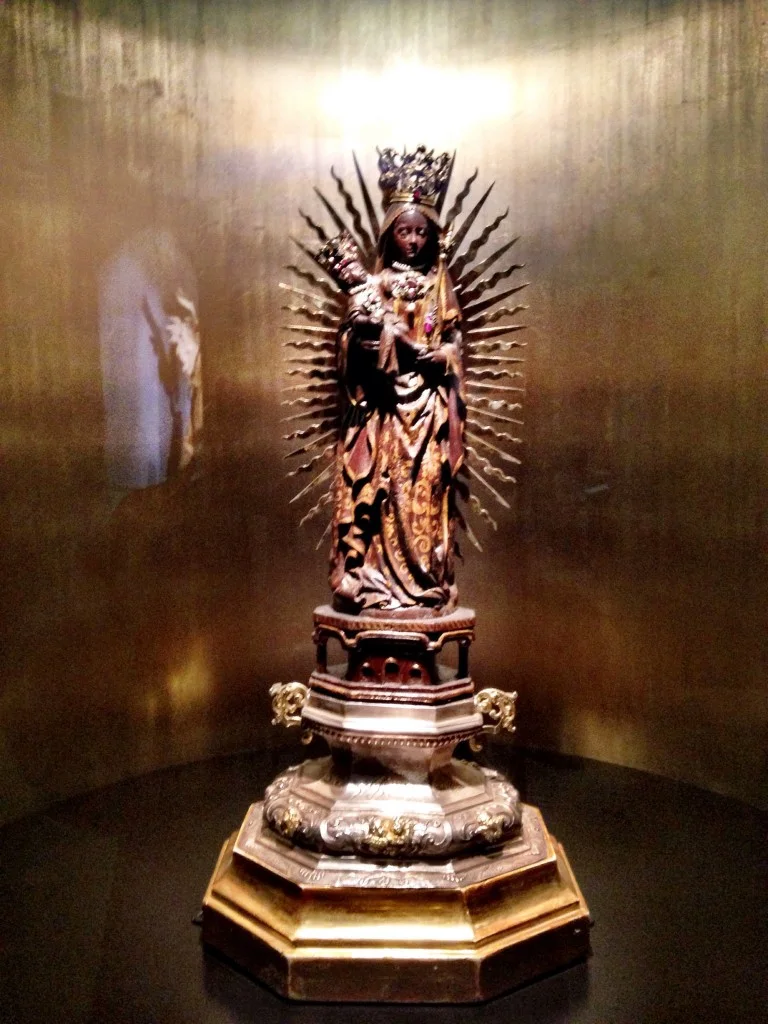

The main sanctuary is in the style of a Baroque ballroom, glittering with silver and gold. The altar table has four silver busts of the holy men who had a special relationship with the Virgin Mary: St. Joseph, St. John the Baptist and the Apostles John and Joachim. Other niches hold additional statuary created in 1947.

Frescoes in certain windows of the church depict scenes from the life of Mary. The ceiling decor was reconstructed from old engravings in 1959. Other ceiling paintings were created as late as 1973. The church’s organ was consecrated in honor of Father Mayer in 1994. Built in Munich in accordance with an engraving that dates to 1730, it is contained in two boxes between the south windows. The organ has 50 stops with 2,905 pipes.
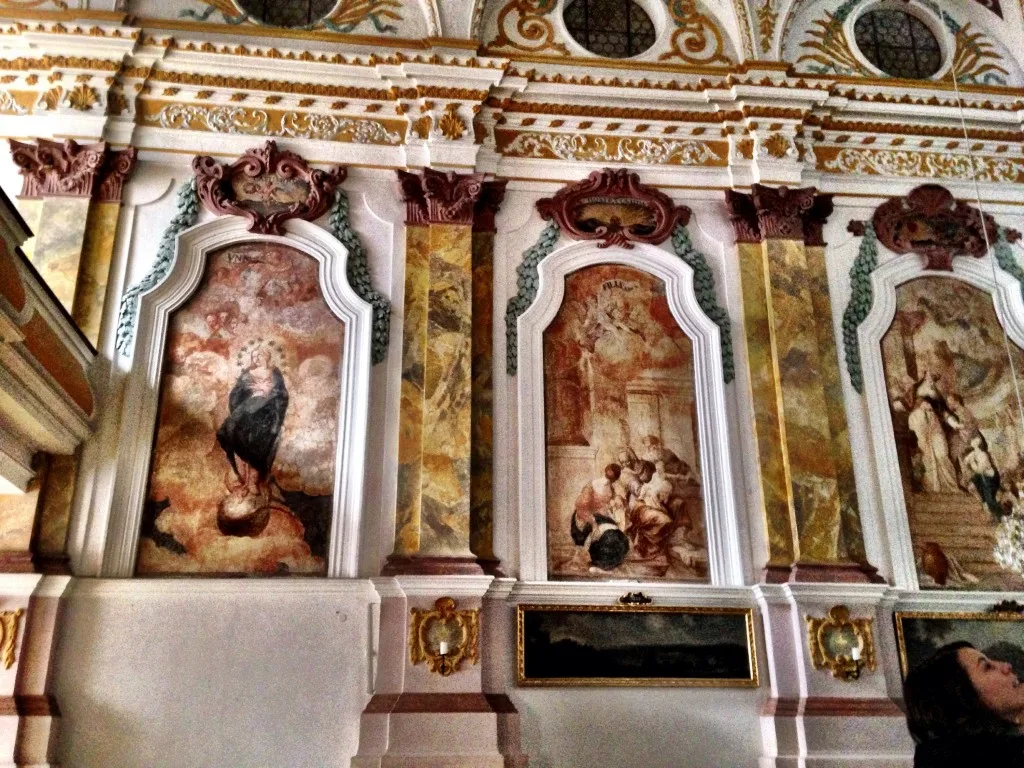
The lower church is comprised of an arched crypt-like room, which was originally used as a print shop for tracts and books in the 17th century. In the 19th century, it was converted into an alternative place of worship. Sculptures depicting Mary the Mother of God, the fall of Adam and Eve and angels holding the coats of arms of the city of Munich and the state of Bavaria were created about 1925 by Franz Drexler.
By far, the most stunning elements in the lower church are the life-size Stations of the Cross. These are neo-baroque carvings done out of linden wood between 1892 – 1898 by Hans Sprenger, from models by Joseph Elsner. I took quite a few photos of the Stations, but will just share several with you. You can click on each of my photos to see it in full, or if you’d like to see all of the Stations in greater detail, click here:
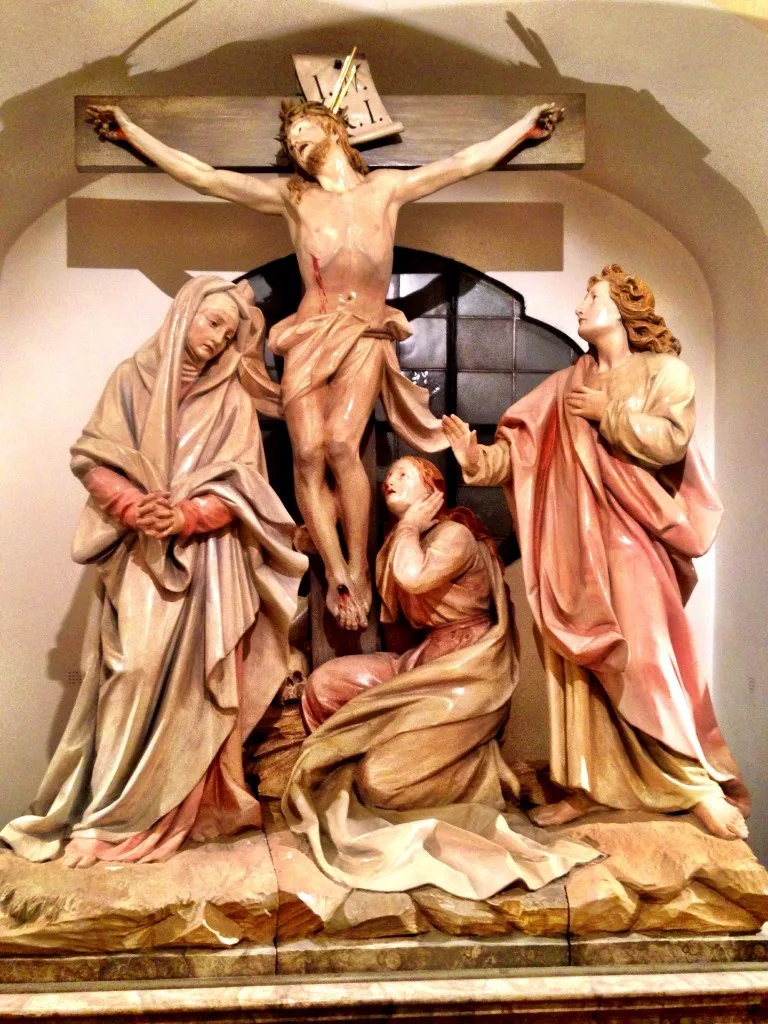

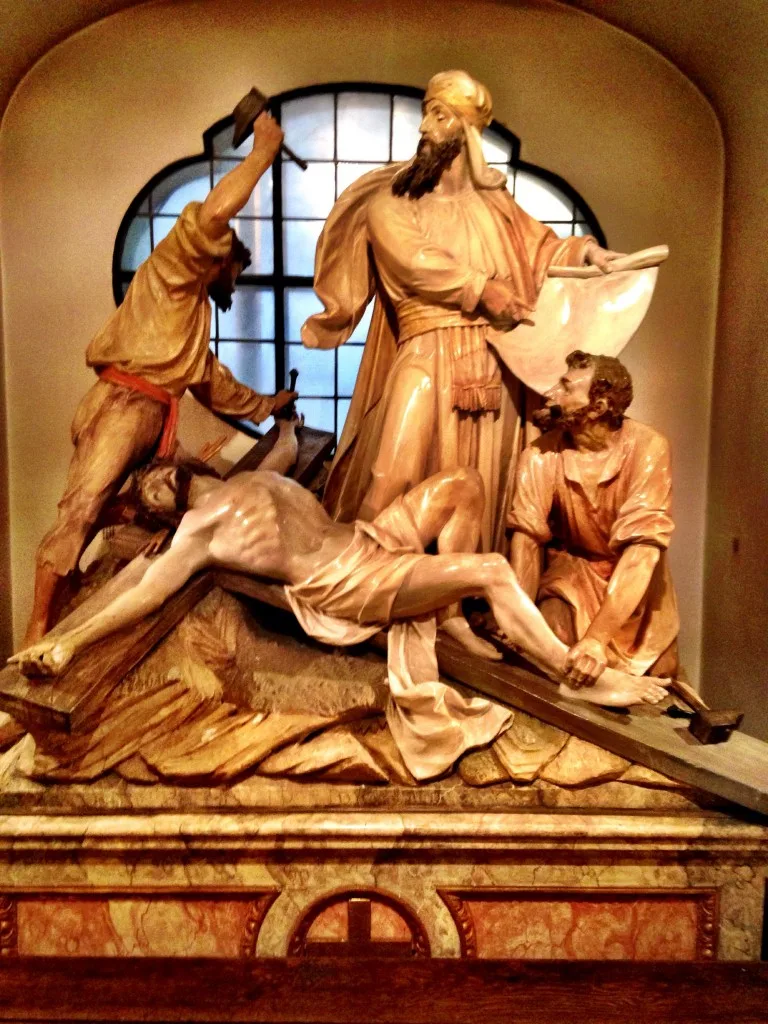
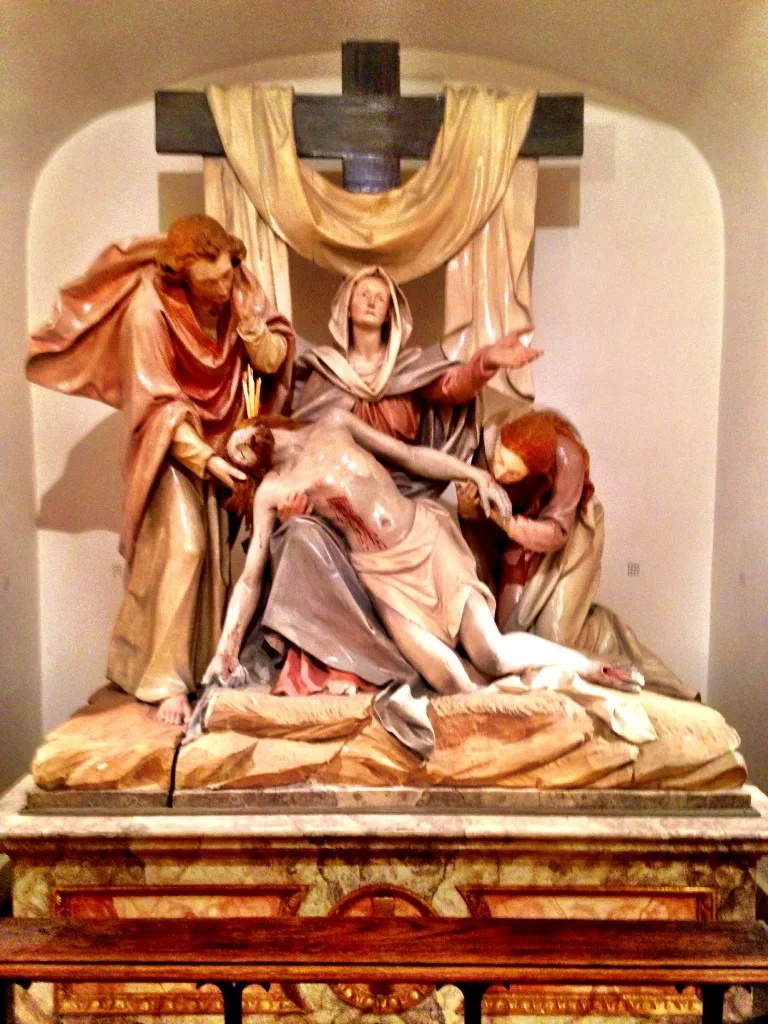

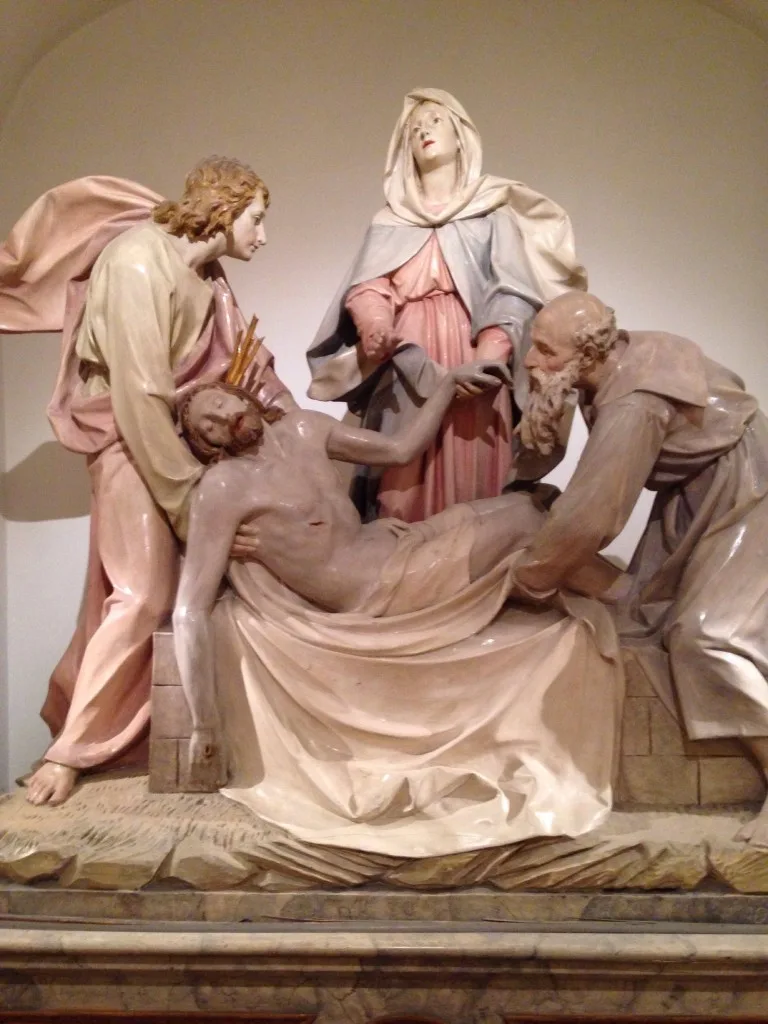
This charming “Christkind” came to the Marian congregation in 1817 and is displayed in the Upper Church at Christmas time.
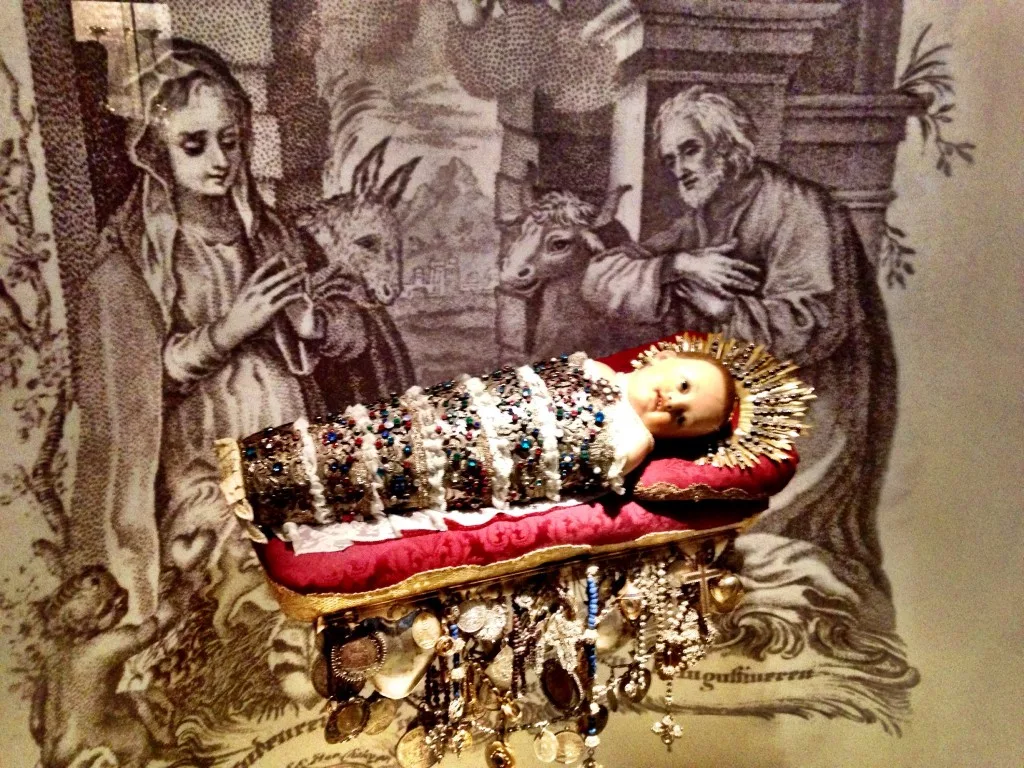
There is a changing display in the Krippe (“Crib”) area of the under church which is comprised of architectural elements, and jointed figures who can be dressed and arranged in scenes that depict various texts in the Bible. In January 2014 when we visited, the scene was taken from Matthew 2:11, the Adoration of the Magi.
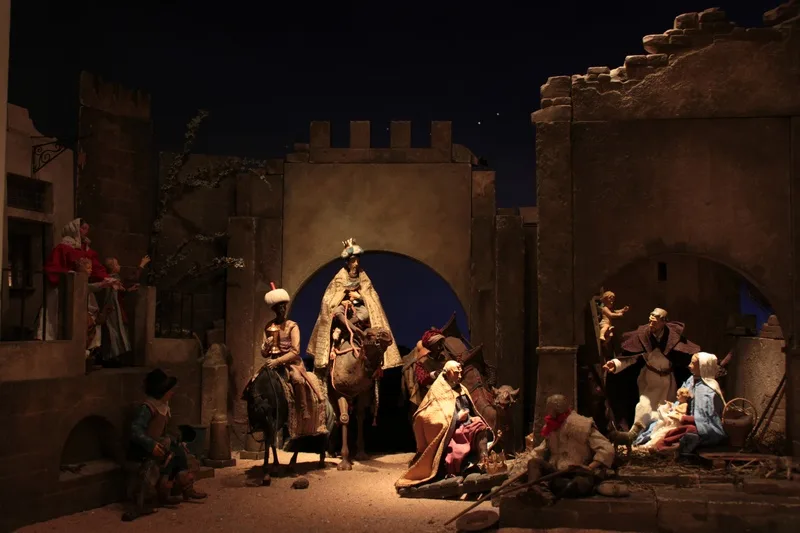
Father Mayer’s remains are buried before the altar of the lower church. This is now a place of pilgrimage and prayers for intercession. Who was this priest and why the pilgrims? We were ashamed to admit we’d never heard of him.


Rupert Mayer was born in Stuttgart in 1876, attended high school in Ravensburg and took theological studies in Fribourg, (Switzerland), Munich and Tübingen.He was ordained in Rottenburg in 1899 and appointed vicar of Spaichingen in Baden-Württemburg the same year. In 1900 he entered the Jesuit order in Feldkirch and undertook further philosophical and theological studies in the Netherlands, where he simultaneously served in the novitiate, tertiate and Jesuit missionary outreach. After completion of his latter vows, Father Mayer arrived in Munich in 1912 as Chaplain for Catholic immigrants in the city.
When the first World War broke out, Father Mayer volunteered as a field hospital chaplain, but quickly asked for reassignment as a Division pastor. As such, he served with combat units in Alsace, Galicia and Romania. During the fighting at the front, he would crawl from soldier to soldier to speak God’s word and administer the Sacraments. For this, he was awarded the Iron Cross for bravery in 1915. In Romania the following year he sustained an injury from a grenade that resulted in the amputation of his left leg.
Following the war, Father Mayer served in various capacities in Munich: as prefect for the Marian congregation, and duties including preaching and confession at St. Michael’s. In 1925, he introduced services at the train station in Munich, and in 1926 was appointed prefects and church council at the Munich Civic Hall. As such, he became an influential leader in the city.
In 1933, when Hitler began a defamation campaign against German religious orders, Father Mayer spoke out from the pulpit of St. Michael’s, maintaining that man must obey God more than men. Between 1933 and 1938, he courageously confronted National Socialism despite a Gestapo gag order. His first arrest for failure to comply with the gag order occurred in 1937.
One of his superiors, Cardinal Michael Faulhaber, whose relationship with the Nazi government appears to have been complicated – he both opposed its policies as incompatible with Christianity but recognized it as a legitimate entity – actually took to the pulpit at St. Michael’s in support of Mayer’s arrest. Faulhaber believed that the clergy should be law abiding. After public trial before the Special Court in Munich, Father Rupert Mayer was sentenced to six months in prison for “vicious attacks on the party, and state and pulpit abuse.” This arrest was later repealed.
Several additional arrests for failure to comply with the speech ban occurred in 1938 and 1939, which led to Father Mayer being imprisoned in Wittelsbacherpalace in Munich, and then transfer to solitary confinement in Sachsenhausen concentration camp. When ill health threatened, the Nazis were determined he would not become martyred to the cause and transferred him to the Ettal Monastery, where he was liberated by the U.S. Army in May, 1945.
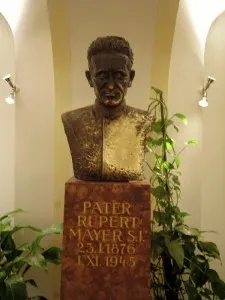
On November 1, 1945 while performing Mass at St. Michael’s, Father Mayer suffered a stroke and died. Ironically, Cardinal Faulhaber opened the process for Mayer’s beatification in 1950, which was solemnized by Pope John Paul II at the Olympic Stadium in Munich in 1987.
Since 1948, Father Rupert Mayer has lain at rest in the Bürgersaalkirche, and is visited daily by hundreds of people. There is a bronze bust of the priest so popular with pilgrims that the statue’s left side has been polished by their many touches.
Today, the Marian Men Congregation “Annunciation” in Munich practices charity in the spirit of Father Mayer, with a special emphasis on the weak and vulnerable. Their subsidies are given to established charities and welfare associations, but also to individuals who are in social, economic or psychological distress.
Why is the story of Father Rupert Mayer so captivating yet so relatively unknown? Again, it’s a complicated matter. While religious resisters like Protestant Dietrich Bonhoeffer and the Archbishop of Toulouse have achieved a degree of notoriety, the relationships organized religion had with the National Socialist party remain open to debate. The ideological duality of Catholic resistance to Nazi Germany lay in the extent to which religious and moral issues overlapped those of politics and race. Religious personages were eager to defend the assaults made on religious organizations, but their vigor did not extend to all aspects of Nazi barbarism. Even so, by 1940, a dedicated “Clergy Barracks” was established at Dachau, housing around 3,000 with as many as 2800 not to survive the war.
It’s easy to make judgments on the past, thinking to ourselves that oh yes, we would be on the side of what’s right and true. Certainly we’d behave in the example of Father Rupert Mayer, standing up for God’s laws against a destructive political monolith. But perhaps not. Things are rarely as black and white as they seem looking back through the clarifying lens of the present. Nowadays there are greater extenuating circumstances, we tell ourselves. We should be able to coexist with conflicting viewpoints, to exercise patience as a strategy, to acknowledge the rights and claims of all, not just some. But it seems to me that’s exactly what was happening in Germany in the 1930’s. Those both for and against the tenets of National Socialism believed fervently in the righteousness of their cause. Others preferred to ride the fence of compromise, balancing appeasement with advocacy in a dance of equivocation. Throughout history, there have always been shades of grey more appealing.
Father Rupert Mayer doesn’t appear to have had the slightest moral equivalence, preaching as he did that the laws of God claim higher status than those of man. It’s a concept distilled by simplicity into a standard. Perhaps that’s what we’d best do today, as well. Distill a belief using simplicity without the need to equivocate. Draw a line in the sand. Say to ourselves, this is the way things should be and take an uncomplicated stand. Something to think about after a visit to the Bürgersaalkirche.
More Information: Bürgersaalkirche is located at Neuhauser Strasse 14 in central Munich. The church is open daily to visitors. Masses with sermons are held on Sundays and public holidays at 9:30 and 11:30 am. Holy Mass in Italian is held at 6pm on Sundays and public holidays. On weekdays, Rosary is said in the Upper Church at 11:15 am, with Holy Mass at noon. On Wednesdays, Holy Mass for the canonization of Father Rupert Mayer is held at 7:30 am in the Lower Church.

In March, 2014, Bavarian cinemas began showing “Father Rupert Mayer,” a feature film shot on location in the Bürgersaalkirche and other sites, and directed by the controversial Damian Chapa. Starring Stacy Keach, Daryl Hanna and Oliver Gruber, the film was backed by Sankt Michaelsbund in Munich. The film’s trailer is embedded below:
Tips for Trip Success
Book Your Flight
Find an inexpensive flight by using Kayak, a favorite of ours because it regularly returns less expensive flight options from a variety of airlines.
Book Your Hotel or Special Accommodation
We are big fans of Booking.com. We like their review system and photos. If we want to see more reviews and additional booking options, we go to Expedia.
You Need Travel Insurance!
Good travel insurance means having total peace of mind. Travel insurance protects you when your medical insurance often will not and better than what you get from your credit card. It will provide comprehensive coverage should you need medical treatment or return to the United States, compensation for trip interruption, baggage loss, and other situations.Find the Perfect Insurance Plan for Your Trip
PassingThru is a participant in the Amazon Services LLC Associates Program. As an Amazon Associate I earn from qualifying purchases.
To view PassingThru’s privacy policy, click here.

Gus
Friday 20th of February 2015
I know the story was about Father Rupert Mayer, but I jut need to say the interior of the Bürgersaalkirche Upper Sanctuary is spectacular. I think I would be looking up instead of paying attention to the front!
Betsy Wuebker
Tuesday 24th of February 2015
Hi Gus - Without a doubt, it is spectacular. It didn't feel seemly to intrude upon the worshipers in the sanctuary to take photos, but we did spend quite a bit of time there. There is plenty of impressive detail to be sure.
Margot
Monday 16th of February 2015
I was curious to know the story of this man. Since I am the daughter of a WW II veteran and Purple Heart recipient I took great interest in his life especially when I read he too had lost a leg due to the war just as my father who was my hero. So many young people today know so little of this time in history I hope more stories are written in the future in hopes of rekindling an interest about the brave men and women of this time and knowing that our lives would not be as they are today without them Thank you
Betsy Wuebker
Monday 16th of February 2015
Hi Margot - Glad we could share our appreciation with you.
Revati
Sunday 15th of February 2015
I hadn't heard of Rupert Mayer before, but I absolutely love how you presented the facts, bringing it alive, almost as a story! (It would be wonderful to have you as the tour guide obviously!)
Betsy Wuebker
Monday 16th of February 2015
Hi Revati - Wow, thank you so much. I'm glad you enjoyed it. It really says something about the impression this place and Father Mayer had on me to be writing about it a year later.
MAD Travel Diaries
Sunday 15th of February 2015
Wow, this is an incredible insight into a place I did not know existed! Thank you for sharing this, I think Rupert Mayer's story makes it even more appealing and makes me want to visit Munich earlier than I have planned.
Betsy Wuebker
Friday 27th of February 2015
Hi MAD Travel Diaries - We love Munich for many reasons. This story is one more.
Sue Reddel
Saturday 14th of February 2015
Visiting Germany and especially Berlin is a tough when you consider all the history. My heritage is German and I often struggle with that and trying to understand the tragic history. Thanks for sharing the information about the Burgersaalkirche and FatherMayer. I'll be sure to visit there on my next visit to Berlin.
Betsy Wuebker
Saturday 14th of February 2015
Hi Sue - I hear you. Both Pete and I have German immigrant ancestry, and we have friends in Germany, thanks to my brother being an exchange student there years ago. We were privileged to host their sons last year in Hawaii, and had a candid discussion about the repercussions of the war years which still live on today. Just make sure you're not looking for the Bürgersaalkirche in Berlin, though. It's in Munich. ;-)